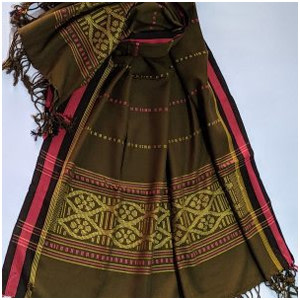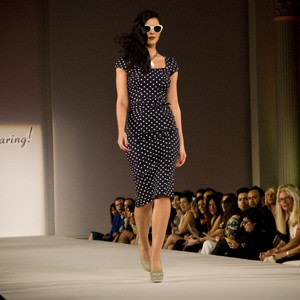Costumes of Different States in India
India is a country with a rich and diverse cultural heritage. One of the most fascinating aspects of Indian culture is its wide range of traditional costumes. Each state in India has its unique clothing style that reflects the region's history, climate, and social customs. In this article, we will take a closer look at the costumes of different states in India.Traditional Costumes of South Indian States
Andra Pradesh
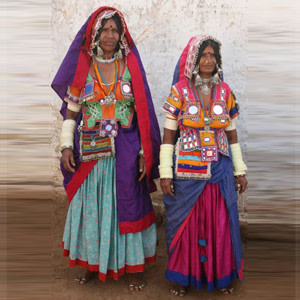
Located in southern India, Andhra Pradesh shares its borders with Telangana, Chhatisgarh, and Odisha, while the Bay of Bengal lies to the east. Known as the "Rice Bowl of India" the state is famous for its weaving and dying industry, particularly for its silk handloom sarees. The traditional attire of Andhra Pradesh is similar to that of other southern Indian states. The common men's dress in this region consists of Dothi, Shirt or Jubha (Kurta). The Dothi is about 2 meters long which is worn around the waist like Lungi. Working classmen generally wear short dhothi and folded about the knee. In coastal region men use a scarf and in rural areas people use a hand woven towel over the shoulder when they do not wear any upper garment. Muslim's wear colored and stripped Lungi, shirt or Kurta and towel.
Women of Andra Pradesh mainly wear Saree and Blouse. Saree is called "Chira" and the blouse is called as "Ravikai". There are 2 different methods to wear saree. Earlier "Ravikai" the upper garment was like that of Maharashtrian Choli which is fastened in front by knotting the 2 sides flaps. Now "Ravikai" with modern cut it replaced by the old one.
The grown up girls wear Ravikai with a long skirt pleated all around. Over the skirt, they wear "Pammatta" (half-saree) which does not fully cover the skirt. Some Muslim women wear Salwar Kameez. Women wear original handloom sarees, mostly made of silk, with different regions renowned for their unique styles, such as Pochampally, Dharmavaram, and Uppada. Young women often wear the two-piece traditional sari called the Langa Voni, while for marriage ceremonies, the bride wears a red silk saree with gold plating, and the groom wears a kurta and full-length dhoti. With the influence of western culture, people in urban areas wear western clothes to the office, with women preferring salwar kameez or western clothing over sarees, and youth and kids opting for pants, shirts, and t-shirts.Women of Andra Pradesh mainly wear Saree and Blouse. Saree is called "Chira" and the blouse is called as "Ravikai". There are 2 different methods to wear saree. Earlier "Ravikai" the upper garment was like that of Maharashtrian Choli which is fastened in front by knotting the 2 sides flaps. Now "Ravikai" with modern cut it replaced by the old one.
Karnataka
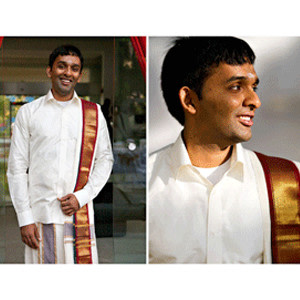
Karnataka, a state in southern India, is known as the Silk hub of India for its diverse silk industry. In Karnataka men use Dhothi called "Dhotara" with a narrow colored border on each side. It is draped around the waist with a costerier tuck as found in Maharashtra. Younger men wrap a colored or white shorter piece of cloth called "Pancha" like lungi in Kerala. This style of wearing the lower garments in prevailed in all the 4 Southern States. Shirt or banians covers the upper part of the body. Elders often use a piece of cloth on their shoulders "Angavastra" and there are 2 types of headdress "Pheta" and "Rumal". Rumal is a large piece of cloth and is not often used. "Pheta" is used by the Mysore people. The border is attached with a lace.
The dress of women consist a Saree called a "Seere" and blouse, which is tight fitted and known as "Kuppasa". The saree has white borders called "Aona". Muslim costume is one the colorful one. Muslim women wear either saree and blouse or pyjama and full sleeve shirt.
The dress of women consist a Saree called a "Seere" and blouse, which is tight fitted and known as "Kuppasa". The saree has white borders called "Aona". Muslim costume is one the colorful one. Muslim women wear either saree and blouse or pyjama and full sleeve shirt.
Kerala
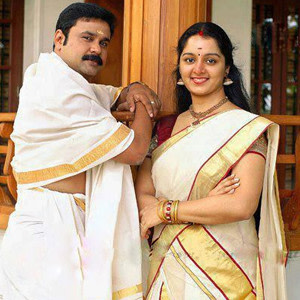
Kerala is a state with temperate climate enhanced with greenery allover. There are different communities and all the communities have similar pattern of dressing. The male garment - a lower garment Dhothi which is wrapped around the waist and tucked at the front waist. They usually wear a upper garment, but they also use a small piece of square fabric on their shoulders. They usually don't use any footwear or headdress. The use of headdress is conditional depending upon the community.
A female garment basically have 2 pieces, upper garment and lower garment. The upper portion is tight fit garment with sleeves which may be either short or 3/4 in length. The length of the garment ranges from midriff to the waist. The lower garment is a rectangular piece of fabric which is tucked at the waist (front) after drapping around the waist. They use ornaments made of gold. They use bangle, necklace, earrings, anklets etc. This is a state where there is no specific color used during wedding ceremony. Married women give very much importance to "Mangalsutra" or "Thali". It's the main symbol of married women. Teenagers use skirt, blouse or a frock.
A female garment basically have 2 pieces, upper garment and lower garment. The upper portion is tight fit garment with sleeves which may be either short or 3/4 in length. The length of the garment ranges from midriff to the waist. The lower garment is a rectangular piece of fabric which is tucked at the waist (front) after drapping around the waist. They use ornaments made of gold. They use bangle, necklace, earrings, anklets etc. This is a state where there is no specific color used during wedding ceremony. Married women give very much importance to "Mangalsutra" or "Thali". It's the main symbol of married women. Teenagers use skirt, blouse or a frock.
Tamilnadu
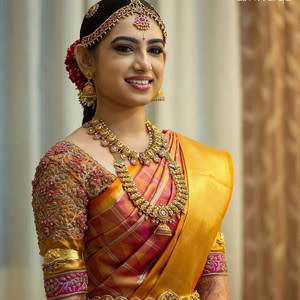
In Tamilnadu, Dhothi is known as "Vasthi" which is worn with a tuck in different ways. Commonly they used Dhothi or "Ottavasthi" as if like lungi in Kerala without an upper garment, instead they use a scarf called "Angavastra". The length of the saree varies from 6 to 9 meters. The standard mode of wearing saree is "Madisar". The saree is known as "Sclai" or "Pudavai". This style of wearing saree is like that of Brahmins. They use a tight fit blouse called "Ravaikai". The grown up girls use "Dhavani". They use full skirt with more pleats along with a blouse and a shawl to cover the bosom as if like saree. This half saree is known as "Dhavani".
Telangana
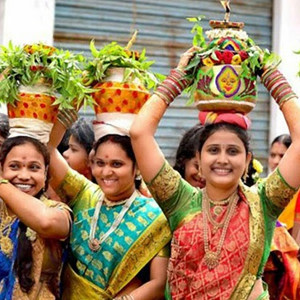
The production units of cotton in Telangana are popular all over the world. Telangana is also renowned for its exquisite Dyeing and Weaving techniques. The most seen costume worn by women is Saree along with Salwar Kameez, Churidar and Langa Voni (also known as Pavadai Daavani or Langa Davani). Langa Voni is worn by young girls between puberty and marriage. It is also known as a Two-piece Saree or Half Saree. Pochampally & Gadwal are the most famous Sarees made in Telangana. Bhoodan Pochampally, a town in Yadadri Bhuvanagiri district is known for its Ikat style. Pochampally weave is called Ikkat or Tie & Dye weave.
Pacha, the traditional Dhoti is the common costume for male. Earlier, the Nizams and other nobles of Hyderabad preferred to wear Hyderabadi Sherwanis. Presently, during wedding ceremonies Groom's mostly wear Sherwani.
Pacha, the traditional Dhoti is the common costume for male. Earlier, the Nizams and other nobles of Hyderabad preferred to wear Hyderabadi Sherwanis. Presently, during wedding ceremonies Groom's mostly wear Sherwani.
Coorg
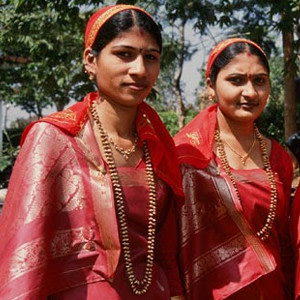
The Coorg's have their own characterstics dress for both men and women. Coorg's men wear trousers, shirt and coat on festival occasions. They use dark color front open coat reaching below the knees. The sleeves of the coat reaches just below the elbows expressing the arm of the white shirt, worn under the thick coat. A red color or blue color shades of cotton or silk is worn around the waist. A turban which is large and flat at the top is worn covering the nape of the neck.
Coorg's women wear saree in a special way. First end of the saree is wrapped around the waist and tied by a string. After forming pleats, its tucked at the back instead of front. Other free end is brought from behind and under right arm and by covering the bossom, the saree is fastened under the left arm. The rest portion is taken to the front through right shoulder, sometimes this end is being used to cover the head as if like Kashmiris. The head is covered with a scarf colored scarf.
Coorg's women wear saree in a special way. First end of the saree is wrapped around the waist and tied by a string. After forming pleats, its tucked at the back instead of front. Other free end is brought from behind and under right arm and by covering the bossom, the saree is fastened under the left arm. The rest portion is taken to the front through right shoulder, sometimes this end is being used to cover the head as if like Kashmiris. The head is covered with a scarf colored scarf.
Traditional Costumes of North Indian States
Jammu
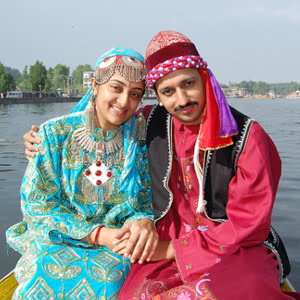
It's a state which is situated Northern most part of India. This state has got maximum Muslim influence in their tradition, custom and also in their costume. They also have the influence of state of Punjab. The female garment is Salwar Kameez with a difference that it is very loose fitted. The upper garment is called "Pheran". The length is upto the mid-thigh or calf. It hangs loose over the body and also over the sleeves. They also have a sleeveless jacket under the Pheran. The lower garment is also very loose and the length may be either till the end of the leg or covering the foot. A scarf which is similar that of dupatta is worn over the head, which is tied along with the hair and the remaining portion is sometimes brought to the front. The scarf is decorated with typical embroidery design. The usage of jewellery is more, especially silver ornaments. They use a huge earings which covers maximum part of the ear and also hangs down. They used a typical type of ornament to cover the forehead and it resembles as if the end of the scarf is attached with this ornament. Sometimes the forehead ornament is continued to the earing. They also use bangles. They use fine wool of hilly goat which are soft. They also use brocade shawls called "Chenar" which is embroided with "Kashida" work.
The male garment is "Kafthan". This is a loose garment. It has two parts - The upper garment and the lower garment.The upper garment is a long kurta with full sleeve which are loose at the top and towards the lower portion, itbecomes little bit tight. It has curve ends rather than pointed ends like ordinary kurta. The length is upto theknee. The lower garment is fastened at the waist, the length continues till the end of the leg. It is highly pleatedat the top and towards bottom it becomes tight. They use a head dress which is a cap made of either wool or fine cotton. Sometimes they also use a coat over the Kafthan, which is half sleeve coat with front opening and the length is upto the waist. They use footwear with flat heels.Himachal Pradesh
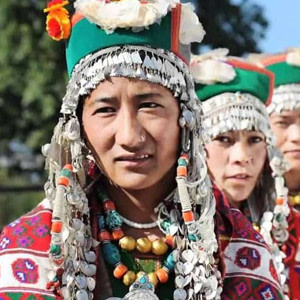
There are different communities in this state but the most dominating community is Daddi. Himachal Pradesh is another state which in surrounded with snow and mountians. The universal dress of Himachal Pradesh is called "Chola" which resembles gown, the length reaches upto the ankles having full sleeves. Both the sleeves as well as the body part is loose fitted. The "Chola" is made of thick woolen material. They usually do not use inner garments. Now the wool is transformed to cotton and the length reduced til the calf along with this a lower garment is used which is tight fit. In certain part of Himachal Pradesh the "Pheran" and "Salwar" is also popular. The Gaddi's wear an oval shaped cap as headress which are richly decorated with bead work. Sometimes with silver ornaments and feathers. The male garment is also similar to that of female, but they don't use any lower garment. Even the headress is same for men. Female use rich ornaments especially neck ornaments, earings which are ornamented with shells, beads and other such materials.
Punjab
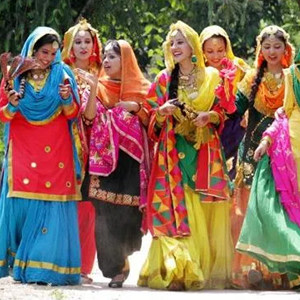
The Punjab's are found to be one of the most active people of India. It is very much famous for wheat cultivation. The main occupation of the people is connected with agriculture. The attire of this region is one of the basic attires of India.
The female garment includes Salwar Kameez with a long shawl called Dupatta of about 3 to 3.5 yards in length called as Dupatta. Salwar is a lower garment which is tied at the waist and has separate channels for each leg with length is till the end of the leg. It is a loose garment highly pleated at the top. The Kameez is an upper garment which is tight fit and length is upto the mid thigh. The sleeves are also tight fit with a length of 3/4th of the arm. Along with this, Dupatta is worn in a manner, in which the middle portion cover the bosom and the two ends are hung down at the back over the shoulder. It plays a very important role in girl's status. Matured girls and married women's have to cover their head with Dupatta in front of the their elders, especially male members.
In bridal costume Red colour with "Rich work of golden threads" are used. They don't give much importance to ornaments, but married women have to wear nose rings and toe ring. During marriage ceremony they also use Red glass bangles.For male the upper garment is a long kameez called "Kurta". The length is upto the knee, which is loose fitted. The lowergarment is a square shaped fabric which is wrapped around the waist. The length is just above the ankle. It is draped insuch a manner that the end pleats which are at the bottom will be longer and when it comes up it becomes shorter. The pleatsare tucked in the waist. A typical community called "Sikh" which is found only in Punjab, uses a typical head dress called "Pagadi" or "Turban". It is a very narrow piece of material which has to be folded and knotted in a typical manner which is raised at the front and towards back it goes down. The finished Turban can be easilyworn and taken off like a cap. Men of other community wear head dress, occasionally which are made of short piece of cloth compared to that of Pagadi's length. The knotting style is also different. During wedding ceremony they use "Sherwani".The female garment includes Salwar Kameez with a long shawl called Dupatta of about 3 to 3.5 yards in length called as Dupatta. Salwar is a lower garment which is tied at the waist and has separate channels for each leg with length is till the end of the leg. It is a loose garment highly pleated at the top. The Kameez is an upper garment which is tight fit and length is upto the mid thigh. The sleeves are also tight fit with a length of 3/4th of the arm. Along with this, Dupatta is worn in a manner, in which the middle portion cover the bosom and the two ends are hung down at the back over the shoulder. It plays a very important role in girl's status. Matured girls and married women's have to cover their head with Dupatta in front of the their elders, especially male members.
Uttarakhand
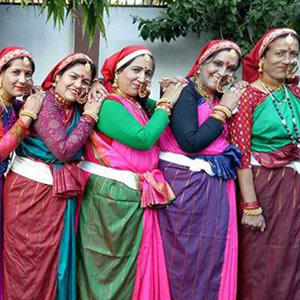
Uttarakhand is located in the Northern Part of India which mainly comprises of the Kumaonis and Garhwalis. Garhwali Men wear a Lungi or a Dhoti as the lower garment and Kurta as the upper garment. Few other men also wear Kurta Pajamas, Sweaters & Woolen Jackets. Young men also wear Topis whereas older men are used to wearing Turbans. During weddings, men wear a Yellow Kurta with a Dhoti. Kumaoni men also wear neck and hand jewellery.
Women drape a Saree which is called Sarang, tied in a particular way with proper pleats where the pallu goes from the front and knotted over the left shoulder, with a waist band made of cloth. Earlier, the saree was worn with a full sleeves Angra (blouse) with buttons made from silver. They also wear a full sleeve sweater over the saree and blouse which protects them from the extreme freezing weather. Married women normally wear silver ornaments known as Hansuli. Kumaoni women of Uttarakhand wear a long skirt called Ghagri along with Orni and Choli. Lehenga, Ghaghra & Choli and Rangwali which are designed with gold and silver tatting is the bridal costume of Kumaoni women.
Women drape a Saree which is called Sarang, tied in a particular way with proper pleats where the pallu goes from the front and knotted over the left shoulder, with a waist band made of cloth. Earlier, the saree was worn with a full sleeves Angra (blouse) with buttons made from silver. They also wear a full sleeve sweater over the saree and blouse which protects them from the extreme freezing weather. Married women normally wear silver ornaments known as Hansuli. Kumaoni women of Uttarakhand wear a long skirt called Ghagri along with Orni and Choli. Lehenga, Ghaghra & Choli and Rangwali which are designed with gold and silver tatting is the bridal costume of Kumaoni women.
Haryana
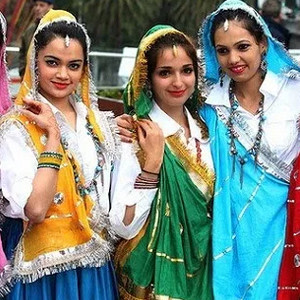
The influence of Punjab are seen in the costume of Haryana particularly on the border area. In the southern region away from the border of Punjab, we find men wearing Dhothi, Kurta or Shirt and Turbans. A cotton "Chadar" or blanket is used as an upper garment especially in winter. There are mainly 3 communities in Haryana - Jat, Rajput and Ahir and they tie their turban in their own styles.
The women of these 3 communities have prominent difference in their dresses. A Jat women wears a "Ghaghri" (skirt), shirt and a Printed Orna. The Ghaghri resumbles the Rajasthan Ghaghra. The color they prefer are Red or Black. The women's shirt is of like that of men's shirt with full sleeve collar and cuff. It may be long or short. When the fashion changes younger women prefer Salwar-Kameez. The Ahir women wear a skirt called "Lehenga" and a blouse called "Angia" with an Orna. The Orna is broad enough to cover the bossom. It is generally Red or Yellow with Silver fringes. The dress of Rajput women is similar to that of Ahir women but Orna is of white fringes.
The women of these 3 communities have prominent difference in their dresses. A Jat women wears a "Ghaghri" (skirt), shirt and a Printed Orna. The Ghaghri resumbles the Rajasthan Ghaghra. The color they prefer are Red or Black. The women's shirt is of like that of men's shirt with full sleeve collar and cuff. It may be long or short. When the fashion changes younger women prefer Salwar-Kameez. The Ahir women wear a skirt called "Lehenga" and a blouse called "Angia" with an Orna. The Orna is broad enough to cover the bossom. It is generally Red or Yellow with Silver fringes. The dress of Rajput women is similar to that of Ahir women but Orna is of white fringes.
Rajasthan

Rajasthan is a state of dry weather. To overcome this dullness they prefer bright colors. A female costume of this state is "Ghaghra", a skirt with high vertical gathers or pleats. The length of skirt starts from the waist, till just above the ankle. "Ghaghra" is worn along with an upper garment called "Choli". The Choli has short sleeve and the body length is upto the midriff. The Choli is back open and is fastened with the help of strings. It covers the back part. The Ghaghra and choli is continued with the help of "Veil", which is tucked at the front waist and its taken from back over the right shoulder covering the front portion. Married women cover their head with the help of "Orna" before placing it to the front. In the bridal costume, the sleeves of the Choli, hemline of the skirt or Ghaghra and Veil is highly decorated with mirror and metal work. Married women gives much importance to toe rings. Rajasthani girls usually use nose rings and also bangles to cover their hands. The portion between the end of the Choli sleeve and elbow is also covered with the help of typical type of bangles. They also use head ornament which has an embossed effect. They use a thick anklet which covers a portion between the end of the skirt and the end of the leg. Rajasthan's women use heavy silver ornaments.
The male garment includes an upper garment called "Kurta" which has a length just below the waist or till the thighs. They wear a headress which is called "Turban" or "Pakadi" which is made of long cotton fabric. The headress is worn by all men and sometimes by small boys. The members of the royal family use a pointed footwear, which has no heals.Uttar Pradesh
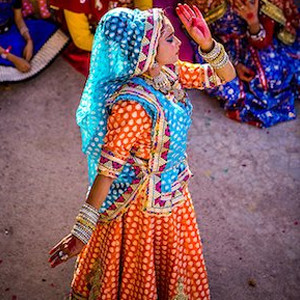
Uttar Pradesh is an important state in Indian history for their costume because it has a blend of both Hindu and Muslim culture along with the blend of costumes. Ghaghra and Choli are worn and well accepted by the Hindu women. The prominent garment of female include saree and blouse. The Ghaghra, Choli and Veil are worn in a typical style and a similar pattern is maintained even for the saree. Saree is supported with the help of basic garment called Petticoat. The upper garment or the blouse, may or may not have sleeves. The saree is wrapped starting from the front waist. It is then pleated neatly and is tucked at the front waist. The remaining portion is taken from the back and falls over the bust through the right shoulder. There are 2 types of sarees, one is of standard length about 5.5 yards and other of shorter length. The short saree has a resemblance with Orna. The capital of Uttar Pradesh, Lucknow is an old city famous for white thread work known as "Chickenkari".
Most of the cotton sarees of Uttar Pradesh have this typical work and enhances the beauty of the garment. One of the famous silk work is "Brocades" and the Banras saree which are used as an asset during wedding,on sarees and fabrics using metallic gold and silver thread.The nose ornament is a custom during the wedding ceremony, and they continue wearing it even after marriage. The toe ring is another symbol of a married woman. They also give importance to Sindhoor and Bindhi. The male garment has 2 pieces the upper garment Kurta which is a loose garment of full sleeve and the length rangesfrom mid-thigh to the end of the knees. In usual cases they wont use headress, but during ceremonial occasions they use turban. Their drapping style is different from other states and it reveals personal respects or status. During weddings, they use a Long Kurta or Sharwani with a tight fitted lower garment along with flat pointed footwear.Chandigarh
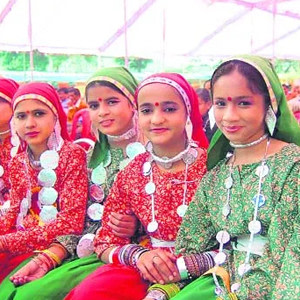
Chandigarh is located at the foothills of Shivalik and has Punjab in the north and Haryana in the east. Chandigarh has a mixture of various traditions and cultures which is reflected in their costumes. Kurta Salwar is the traditional dress for Punjabi and Haryanavi women in Chandigarh. Patiala Suits are also very popular throughout Chandigarh. The usage of Sarees are very less compared to other states in India.
Kurta-Pajama and Punjabi Dhoti are the traditional costume for men in Chandigarh. Bhangra is a prominent folk dance in Chandigarh and people wear Bhangra costumes which include Chaadra (a long piece of cloth) and a Turban (Pagri).
Kurta-Pajama and Punjabi Dhoti are the traditional costume for men in Chandigarh. Bhangra is a prominent folk dance in Chandigarh and people wear Bhangra costumes which include Chaadra (a long piece of cloth) and a Turban (Pagri).
Traditional Costumes of West Indian States
Goa
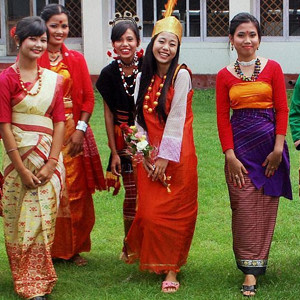
A Saree, 9 yards long referred as Pano Bhaju is the traditional dress of the folk women in Goa. They wear little jewellery to maintain the perfect balance for the outfit. Fishermen are generally seen wearing bright cotton shirts with half pants. The tribal people drape a blanket around their shoulders worn over a Kashti, a loincloth. The women have a very distinctive style as they wear a traditional Saree with a tied knot using their Kunbi Palloo. Goan Catholics follow a mix of Indian & Portuguese dressing. Catholic women wear dresses and gowns. Brides go for a Virgin White Gown for their wedding day whereas Men wear Western Style Suits.
Gujarat
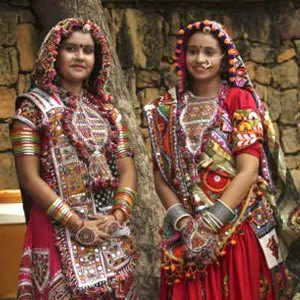
Gujarat is another state which have bright color in their costume. It has a mixture of costume, since it has an influence of both Rajasthan & Uttar Pradesh. In female garment both Saree & Ghaghra are popular. The saree is worn over a petticoat. The difference is that the petticoat of Gujarati women's are tailored with great care and much decoration. Gujarati style of wearing the saree is similar to the style of Uttar Pradesh. The front pleats are shown very elaborately. The Gujarati saree are mainly 8-9 yards in length and almost half of this goes into the pleats. The "Choli" is worn along the saree and is open at the back and fastened with strings, very tightly.
The saree of Gujarati ladies are richly bordered. The borders are either heavily printed or woven along the length. The fabric of Gujarat are famous for their beautiful designs. Another prominent garment is Ghaghra, Choli and Orhna, which are well decorated with beautiful designs with "Kutch work" and "Mirror work" mainly use for ceremonial occasions. They use nose rings and toe rings after marriage, and they also give importance to "Mangalya Sutra" which hangs on a black beeded chain. Sometimes they wear anklets too.
The male garment of Gujarat have two pieces. The upper garment is short fit Kurta with gathers at the down portion. The length of kurta is just upto the waist or just above the thigh. The lower garment is Dhothi but they also use a tight fit salwar. The dhothi is mostly tucked at the back waist. They use turban as the head dress, which is almost similar to that of Rajasthan. During wedding ceremony they also wear "Sherwani".The saree of Gujarati ladies are richly bordered. The borders are either heavily printed or woven along the length. The fabric of Gujarat are famous for their beautiful designs. Another prominent garment is Ghaghra, Choli and Orhna, which are well decorated with beautiful designs with "Kutch work" and "Mirror work" mainly use for ceremonial occasions. They use nose rings and toe rings after marriage, and they also give importance to "Mangalya Sutra" which hangs on a black beeded chain. Sometimes they wear anklets too.
Maharasthra
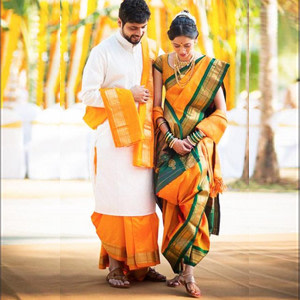
The female garment is 2 piece garments - the saree and blouse. The saree is long length of fine cotton with bright color. It has prominent border at both the sides and the pallu will be same as the border. To drape this saree there is no need of a supporting garment or a petticoat. It is draped in such a manner that the 2 legs have separate passage as the of a Dhothi. The saree is first tuck at the waist and is taken cross wise through each leg till the end of the leg which is tucked at the back. The remaining portion is taken from the back and put in the same manner and as normal drapping style. The border of the saree is prominently shown by drapping in between the legs. Sometimes the remaining pallu which usually hangs down the shoulder is taken over the head. The main ornament of married women is Mangal Sutra which is always put on a black beaded chain. They also use toe-rings and nose-rings. It is a small round shape ring which is exposed to the outer side and is called Nathini. During special occasions, they wear another nose-ring on the nose ridge. Maharashtrian ladies usually wear pearl ornaments.
The men garment consists of a lower and upper garment. The lower garment is Dhothi which is tuck at the back and the upper garment is a tight fit shirt with short sleeves. Along with this certain special community especially fishermen uses another type of garment. In this, the women garment is similar to that of normal Maharashtrian style. The length of the saree is just below the knees. The male costume has an upper garment and the lower garment which is made of short length fabric and is wrapped around the waist, in such a manner that the front gives a 'V' shape and the length is up to the knees and the back is covered till the mid thigh or just below the hips. The upper garment of the ladies is Choli which doesnot have any fastners at the lower portion the waist wide is extended with the same fabric of the garment and is tightened by knotting. The Maharastrain ladies usually tuck their hair and occasionally put flowers.Chhattisgarh
In Chhattisgarh, women prefer to wear sarees in the Kachmora style, which is a local fashion trend. These sarees are knee-length and are known as Lugda, and they are usually paired with a pullover called Polkha. The tribal men of the region wear sleeveless jackets over dhotis made from cotton, jute or linen. They also wear cotton headgear to protect themselves from the sun. The tribal women of Chhattisgarh prefer brightly colored sarees made from a variety of fabrics such as linen, silk, and cotton. They use various dyeing techniques, including the popular tie and dye technique known as batik. Maheshwari, Chanderi Silk, Odisha Silk and Batik Sarees are popular among the women of the region.
Madhya Pradesh
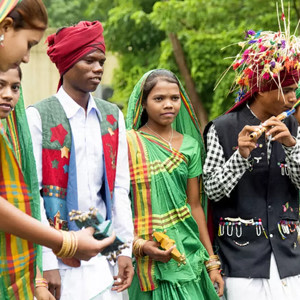
The traditional attire of Madhya Pradesh consists of simple yet elegant clothing. Men wear a white cotton dhoti with short-sleeved, collarless cotton shirts called salukas. Over the salukas, they wear jackets called mirzai or bandi, and adorn brightly-coloured turbans called safa on their heads. Women wear Lehenga, a heavy, ornamented long skirt, and the blouse called Choli, along with an Orni or Lugra, a long, light cloth draped over the head and around the shoulders. The state is famous for its Bandhani cloth or Bandhej sarees, but women mostly prefer to wear lehenga with choli and the Lugra.
Dadra and Nagar Haveli
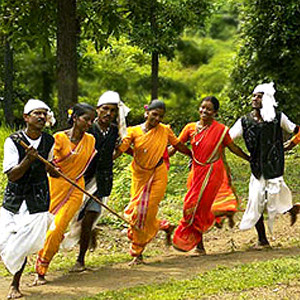
Dadra and Nagar Haveli is yet another place were the costume has its influence from the Portuguese Culture. Dodhia, Kokna and Varli are the major tribes found at Dadra and Nagar Haveli. Men here wear a waistcoat and a shirt with a long Dhoti. The tribal people also wear a headgear called Varli. Women wear Lugden which goes upto the knees. Women of the Varli tribe use to cover their body with a cloth known as Padar. They also wear lot of ornaments made of silver and black metal. Tattoos over body are also seen among the tribal women. Both men and women flaunt beautiful costumes in a wide range of colours, designs and patterns.
Traditional Costumes of East Indian States
Bihar
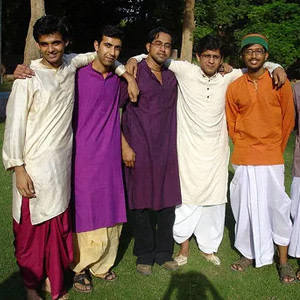
Dhoti-Kurta is the traditional dress for Bihari Men. During special occasions men in Bihar wear Churidar, Pyjamas and Dhoti Mirjai, also known as Kurta and Dhoti. Dhoti or Lungi is a type of loose pants that are wrapped around the legs and knotted at the waist for a traditional look. It looks good on almost every body type. The basic styles are made of cotton and are worn on a daily basis by the men. The fancy ones, however, are worn on festive occasions and weddings.
Women in Bihar are fond of Folk Costumes. Salwar Kameez and Saree are worn by urban population in Bihar. Married women use Tikli, a beautiful ornament and a red colored powder which is called Sindoor over their forehead.
Women in Bihar are fond of Folk Costumes. Salwar Kameez and Saree are worn by urban population in Bihar. Married women use Tikli, a beautiful ornament and a red colored powder which is called Sindoor over their forehead.
Jharkhand
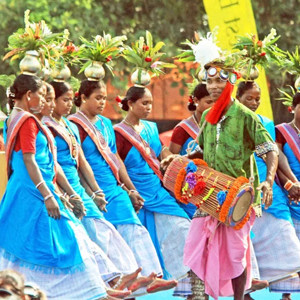
Traditional women in Jharkhand generally wear Sarees and Blouses. Sarees are very colorful and their designs bring richness. Panchi is the traditional lower garment and Parhan is the traditional upper garment worn by most of the tribal people of Santhal Pargana of Jharkhand. Lustrous textured silk sarees are often painted with traditional prints which demonstrates the tribal life (festivals and dances). The recently launched Anjana and Swarnarekha silks has hit the market trend allover India.
There are not many varities of clothing attire for men in Jharkhand. Men wear a one-piece clothing called Bhagwan. Santhal Pargana tribes are wearing the variety of costumes called Santhals and Paharis.
There are not many varities of clothing attire for men in Jharkhand. Men wear a one-piece clothing called Bhagwan. Santhal Pargana tribes are wearing the variety of costumes called Santhals and Paharis.
Orissa
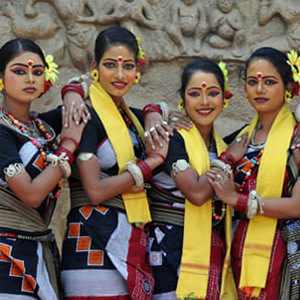
The common male dress is "Dhothi" which is here called as "Dhooti". The Dhooti is worn around the waist in the style of Northern India with pleats in front is called "Koncha" and back pleats is called "MalKoncha" or "Kancha". For the sake of convinence and free movements many people shorten the length of the tucks. The pleats are known as "Phera" or "Oria". No undergarments were used along the Dhooti. Nowerdays, people who live in town area usually use undergarments.
The women of Orissa has a costume similar to that of South Bengal. They use saree as their main costume which is more than 5 meters in length. The free end of the saree is drawn from the right hip to cover the bossom diagonally and goes over the left shoulder. The free end of the saree "Anchal" is thrown over the left shoulder in formal wear. In mordern style the saree is draped close to the body and the remaining portion is gathered up neatly and placed on the left shoulder. The saree is commonly provided with a beautiful borders called "Dhardia". In urban areas women wear a blouse, in village few women only wear blouses, others drap the saree so artfully that they don't feel the need of a blouse.
The women of Orissa has a costume similar to that of South Bengal. They use saree as their main costume which is more than 5 meters in length. The free end of the saree is drawn from the right hip to cover the bossom diagonally and goes over the left shoulder. The free end of the saree "Anchal" is thrown over the left shoulder in formal wear. In mordern style the saree is draped close to the body and the remaining portion is gathered up neatly and placed on the left shoulder. The saree is commonly provided with a beautiful borders called "Dhardia". In urban areas women wear a blouse, in village few women only wear blouses, others drap the saree so artfully that they don't feel the need of a blouse.
West Bengal
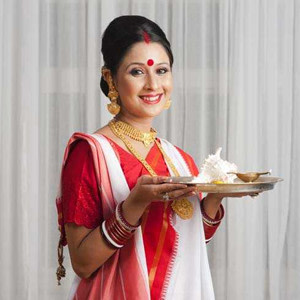
The typical women costume of West Bengal is Saree. There are different styles in wearing this saree namely Kalna, Dhoka, Nadia, Jalpaipuri, Santhal... These different styles are originated from different communities of the society. Each style has its own typical charecterstics. Nadia is most and well accepted style. The traditional saree of the Bengali ladies is called Sanatpuri. It has crapped effect and it is made of fine cotton. The body is of cream or white color with bright red color. The pallu differs according to the end use. In this type, drapping is done while tucking the first layer, wrapping around the pleats and are tucked at the front. The remaining length is allowed to fold diagonally over the bossom which is taken back over the left shoulder under the armpit. In case of married women they have to cover their head and at the end of the saree a bunch of keys are tied. The married women usually wear a lot of bangles especially a pair of bangles made of shell, which is white and red. They attract with very big Bindi and the also use toe ring.
In case of men, the most common costume style is Kurta & Dhothi. The Dhothi is long fine material which is tucked either at the front or at the back and length is til the ankle. Sometimes after tucking the certain amount of cloth is left untucked. This usually is held by hands and reveals the social status of the person. They don't have headdress.Traditional Costumes of North-East Indian States
Arunachal Pradesh
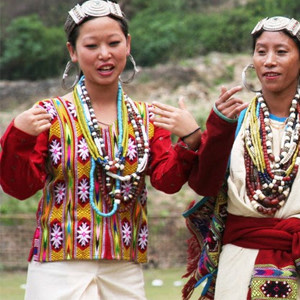
Arunachal Pradesh is a tribal state where socio-culture life blends many traditions and cultures. There are different dressing styles in various parts of the state amoung various tribes. Geometrical patterns like angular designs and zig-zag lines and stripes are most popular here. The type of designs and colors states the symbolic meaning of each tribe. Women wear a full sleeve jackets, sleeveless garment with embroidery with a skirt or petticoat accompanied with a waistcoat or a "Mushaiks". "Gurdam", a skull cap filled with Yak hair is used as a headress. During ceremonial occasions as a part of social status women wear a belt around their waist which is also the symbolic representation of a married women. They also wear a yellow necklace with coiled earrings. The most important accessory worn during the wedding ceremony is a blue colored beaded chain known as "BianSipi". The male costume during weddings include KamkoTop (men's bangles) and a sword called "Bauhche".
Manipur
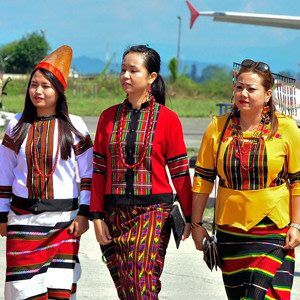
Women wear a Sarong wrapped around their chest as a skirt which is known as the Phanek. To complete the female attire Innaphi, a horizontally and woven shawl or dupatta goes around the upper body. The dress is hand woven with horizontal lines.
The traditional dress for men is Dhoti and Jacket. Dhotis are around 4-5 meters long which is wrapped and knotted around the waist. A white turban (Pagri) is used as the headgear.
The traditional dress for men is Dhoti and Jacket. Dhotis are around 4-5 meters long which is wrapped and knotted around the waist. A white turban (Pagri) is used as the headgear.
Assam
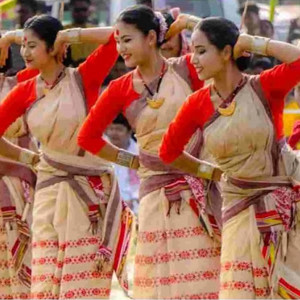
The culture of Assam is traditionally a hybrid one as it is surrounded by seven northeastern states of India. women wear Mekhela-Chador or Riha-Mekhela. The prestigious Muga Silk is the speciality of the traditional dress of Assam. Other few dress they were are Salwar, Saree and Dokhora. For festivals and other special occasions women of Assam love to wear handloom products especially Mekhela Chador, a type of Saree comprising two pieces of cloth, draped on the top and bottom.
Men wear Gamusa, a traditional hand woven scarf with Dhoti and Kurta.
Men wear Gamusa, a traditional hand woven scarf with Dhoti and Kurta.
Meghalaya
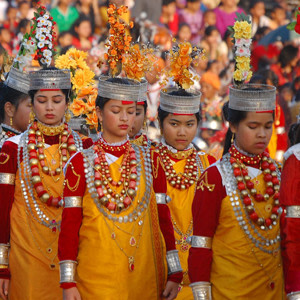
Meghalaya is a state in India with a diverse population consisting of three main tribes: Khasi, Jaintias, and Garos. Each tribe has its own unique traditional dress. Khasi women wear the Jainsem or Dhara, which is an unstitched garment wrapped around the body to give it a cylindrical shape. Khasi men wear a sleeveless coat called Jymphong over an unstitched dhoti-like cloth around their waist. Garo men wear a loincloth while Garo women wear a blouse and an unstitched cloth known as Dakmanda, wrapped around the waist. Jaintia women wear a velvet blouse and a long sarong called Thoh Khyrwang, while Jaintia men wear a long cloth draped over their waist with a jacket and turban. Each tribe also adorns themselves with unique ornaments and accessories.
Tripura
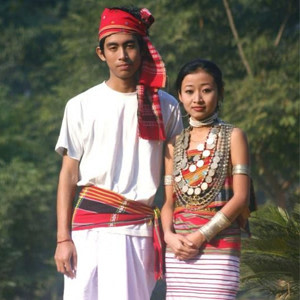
The traditional dress of Tripura consists of two-piece outfits for men and women. Women typically wear a Rinai on their lower body, paired with an intricately embroidered Risa on their upper body. The male equivalent includes the loose towel-like cloth, Rikutu Gamcha, for the lower body and a shirt called Kubai for the upper body. The Rigwnai is a broad piece of cloth that women wrap around their waist, while Risa covers the chest, and Rikutu covers the whole upper body. Nowadays, most Tripuri women prefer to wear a blouse instead of Risa for convenience. The traditional dress is still worn today, especially during traditional festivals. This costume, said to date back to over 4000 years ago, is believed to be the precursor to the modern Indian saree. Different Tripuri clans have their own unique variations, though there is now intermingling among them. The Rignai and Risa fabric are designed with beautiful patterns, and men like to accessorize with bead necklaces. However, these dresses are now mostly worn in rural areas and among the working class.
Sikkim
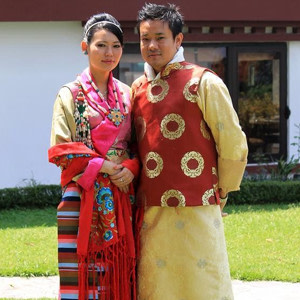
The Bhutia and Lepcha tribes of Sikkim have unique traditional costumes for men and women. The Bhutia tribe wears Bakhu or Kho, a cloak-style dress that is fastened at the waist with a silk or cotton belt. Both men and women wear embroidered leather boots to complement the outfit. The Lepcha men wear Thokro-Dum, which consists of a white pyjama, a shirt, an embroidered cap called Shambo, and Dumpra, a multicoloured handwoven cloth attached to the shoulder and tied with a waistband. On the other hand, Lepcha women wear Dumvum, a silky ankle-length dress, and Tago, a loose contrasting blouse. In addition to these traditional dresses, Sikkimese women have a variety of other ethnic dresses such as the ankle-length Dumvum and the Nyamrek, which are draped over a full-sleeved silk blouse known as honju.
Nagaland
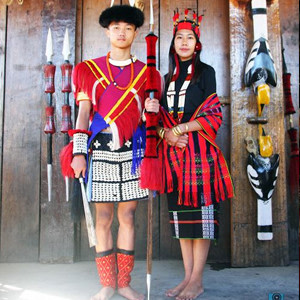
Red is the most predominant color used in the costume of Nagaland. Kilt and Wrapper is the traditional material and costume for men whereas women wear a Skirt, Shawl and an Apron. Kilt is the typical men's waist attire which loops down till the knees is generally of light blue color.
The traditional dress for Nagaland women is the Angami, which comprises a sleeveless top Vatchi worn over the petticoat Neikhro and a white skirt Pfemhou. Women's skirt is a piece of cloth that is wrapped around the waist to cover legs. Ornaments are made of beads, shells, tusks and horns which is worn around the neck.
The traditional dress for Nagaland women is the Angami, which comprises a sleeveless top Vatchi worn over the petticoat Neikhro and a white skirt Pfemhou. Women's skirt is a piece of cloth that is wrapped around the waist to cover legs. Ornaments are made of beads, shells, tusks and horns which is worn around the neck.
Please leave your comments, we do love it!
Most Viewed Articles
Hey, we have amazing content on the latest Fashion, Trends, Style & Creative Arts, and now it's absolutely FREE for you.All you have to do, is just...We always respect your privacy!
Login / Sign-up

